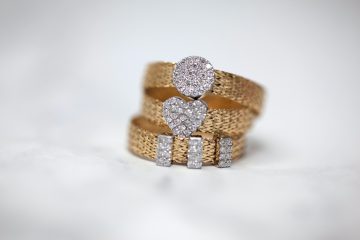Determining rings should not be difficult and complicated – It should be fun, exciting and smooth! Unfortunately, identifying your ring size can be rather difficult without the right methods. At the same time, it is very important that your ring sits comfortably and well on your finger.
Ring sizes are very individual and are quite difficult to measure yourself. We know that ring sizes can cause headaches for the beautiful and big decision to match rings with the one you love. We, have therefore created this ring size guide to help you with just that.
Ring size – what to think about
When measuring ring size, it is important to keep in mind that the fingers swell and are different in size during the day. In the morning and when you are cold your fingers are smaller and in the evening they are usually a little more swollen. Therefore, the size should be tested several times during the day for a relatively safe and accurate result.
Some are bigger over the knuckles than others and you may have to use soap to get off the ring. The main thing is that the ring does not fall off but does not sit too hard on the finger. It is also important to remember that it may differ slightly in how the size is perceived depending on whether the ring has an arched or straight inside. Generally, this becomes evident for rings over 5 mm in width. If you have tested/started from a ring with arched inside, the most common inside, it is recommended to go up about 0.5mm in size (inner circumference) if you order a ring with straight inside. Take help from an expert if you are unsure.
Ring sizes are measured differently around the world. In some countries, the inner circumference of the ring is measured, while in other countries the internal diameter is measured.
For the most accurate result, your size should be measured according to the internal perimeter. NOTE that it is common for many to round sizes to the nearest approximate size. We believe that this can be very misleading. Therefore, it should only be rounded off to the last decimal when measuring by internal diameter. E.g. When choosing a size, it will say Size 60 / 19.1 instead of 19.11.
What to do if you don’t know your ring size
There are several methods to measure your ring size. Try and compare the results of several of the methods to increase the probability that you measure the correct size.
Use a size “chart
Order home or print a ring dimensions “chart”. The ring gauge arrives directly in your mailbox and can be tested in peace and quiet at home. There are many different ring size charts you can use.
Visit a jeweler/goldsmith
Go to a gold shop/jeweler and ask to have your size measured.
Compare with an existing ring
Take an existing ring You have at home that fits and measure the inside diameter of the ring with a slider. Read the dimension in mm. You have now got your size according to the inside diameter. (always round up)
Measure your finger
Tie a thread around the finger you want to measure. Do not tie too hard and then measure the length of the thread in mm. The length of the thread corresponds to your size according to the internal circumference. (always round up)



